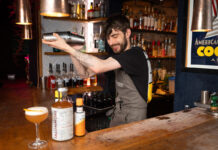Brewers predict a bright future for the ever broadening drinks category
WITH customers still coming out to the on-trade in search of the latest weird and wonderful brews being produced across Scotland and around the globe, where is craft now and what do publicans need to do to keep their sales up amongst growing competition?
These were among the questions posed to a number of craft breweries supplying the Scottish trade, and their conclusions suggested a craft beer future that’s healthy – if a little different.
Karen Moore of Kelburn Brewery said the beer business is “booming” at the moment, both in Scotland and around the world.
“There are some great breweries in Scotland producing a fantastic range of flavours and styles,” she said.
“There has never been a time when consumers have had so much choice.”

Isla Mercer of Lerwick Brewery agreed that the craft market is going from strength to strength as pubs broaden their ranges in response to customer demand.
But is all this variety sustainable?
Mercer seems to think so, suggesting that as consumers expand their craft beer repertoires “their flavours and tastes expand and so there is scope for a much larger variety of beers experimenting with different hops and brewing processes”.
Flavour may not be the only driving force behind increased variety in the craft category going forward as Mercer highlighted the role ABV may play in a market in which high gravity IPAs have been proving popular.
“IPAs are certainly very popular due to their unique and intense flavours,” said Mercer.
“While they will still continue to be popular, they tend to have a slightly higher alcohol content to be able to balance out the intense hoppy flavours and bitterness.
“Therefore, we’re already beginning to see a craving in the market for pale ales that are lower than 4% but still packed with flavour.”
Moore agreed that although IPAs are “trusted” and “well known” and are probably here to stay, there are still plenty of varieties for publicans to play with when ranging.
“[Other styles] are starting to gain popularity, such as stouts and those brewed with more unusual ingredients.
“Indeed there seems to be a trend at the moment for some brewers to produce a beer more whacky than the last one,” said Moore.
Unusual beers aren’t the only new releases breaking the mould. Colin Johnston, operations director at Glasgow craft brewery and venue Drygate, reckons some traditional continental styles could come to the fore as the craft category develops.
“The new frontier in craft beer is increasingly other styles that are less hop-forward, such as Lambics and Sours,” said Johnston.
Despite this, hoppy beers still have their place, said Johnston, as “great seasonal additions” or guest tap pours.
Paul Miller of St Andrews-based brewery and distillery Eden Mill, described Scotland’s evolving craft beer scene as “extremely vibrant”.
And although Miller warned that growth in the category may not continue at current levels, he predicted that the upward trajectory will continue, and that customer expectations will grow with it.
“Choice and quality are important to the consumer and increasing evidence suggests that a good and varied beer range is extremely important to consumers,” he said.
“What will be important is brewers crafting beers to suit trade and consumer needs. A full-
flavoured and lower ABV beer is typical of such a need.”
Petra Wetzel, owner of West Brewery, said that as long as brewers continue to produce high quality beers there will be room for plenty of variety.
“People will always plump for a favourite if pushed but if brewers continue to produce new and exciting products then people will continue to try them,” said Wetzel.
For publicans, getting the most from a broad market is about balance, according to Norman Sinclair, managing director of Orkney Brewery parent company Sinclair Breweries.
“Licensees have to strike the right balance for their clientele but are faced with the space constraints and logistics of storing and conditioning the ales in their cellar,” said Sinclair.
“Know your customers’ favourites but keep guest ales coming in to introduce new taste experiences.”
Market knowledge was also highlighted by Bob Hogg, commercial director at Inveralmond Brewery, who said publicans should ensure they tailor their range to suit their clientele.
“Consumers like to have choice and it is important to keep your offering fresh to stimulate growth, but it also is important to strike a balance between what you know is popular and offering something new,” said Hogg.
Hogg suggested beer tasting events as a way of offering consumers something different, and said there are “a lot of simple and effective ways” to get the most from these events.
“Firstly, making sure people know about it through social media, posters, fliers and good signage outside the premises can pull people in,” he said.
“Offering samples is a good way to encourage consumers to experiment with new beers.
“Probably most important of all is to educate staff and ensure they have a good knowledge of the products they are selling.”



















